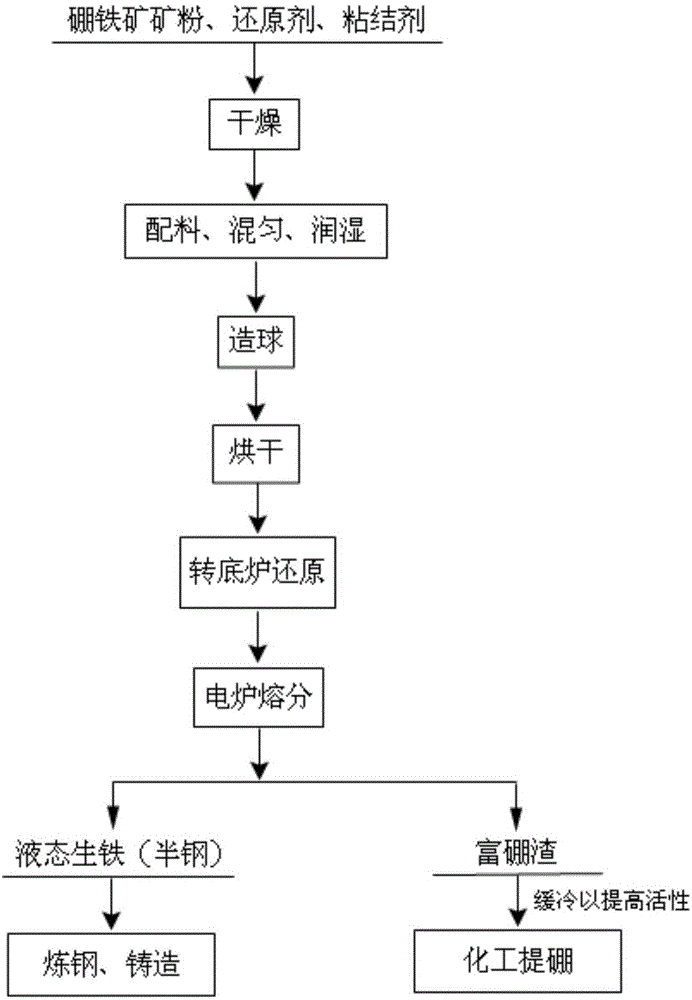Method for comprehensive utilization of paigeite through direct reduction-electric furnace melting separation of rotary hearth furnace
A boron iron ore and rotary hearth furnace technology, applied in chemical industry, resource comprehensive utilization, and metallurgy fields, can solve the problems of no successful implementation, influence on reaction speed, low reduction temperature, etc., and achieve easy automation, fast reaction speed and high strength undemanding effects
- Summary
- Abstract
- Description
- Claims
- Application Information
AI Technical Summary
Problems solved by technology
Method used
Image
Examples
Embodiment 1
[0026] according to figure 1 As shown in the process flow, a certain B 2 o 3 3.26% boron ore ore powder, coal powder with a weight of 20% boron ore weight, and 2% binder with a weight of boron ore and coal powder weight sum are transported to the mixer through a belt for mixing, and the mixing is adjusted. Homogenize moisture to 7%. The mixed material is conveyed to the double-roller ball pressing machine through the belt to make carbon-containing pellets, the pressure is 15MPa, and the size of the pellets is 40×30×20mm pillow-shaped ellipsoid. After the raw balls are dried, they are spread on the carbonaceous refractory material in the rotary hearth furnace in a single layer, and a layer of carbonaceous or refractory material powder with a thickness of 3 to 5 mm is laid on the carbonaceous refractory material in advance. The temperature in the rotary hearth furnace is 1200~1300°C, the residence time of the pellets in the rotary hearth furnace is 15~25 minutes, the metalliz...
Embodiment 2
[0034] according to figure 1 shown in the process flow, will contain B 2 o 3 6.90% boron ore ore powder, coal powder with a weight of 17% of boron ore weight, and 2% binder with a weight of boron ore and coal powder weight sum are conveyed to the mixer through a belt for mixing, and the mixing is adjusted. Homogenize moisture to 7%. The mixed material is conveyed to the double-roller ball pressing machine through the belt to make carbon-containing pellets, the pressure is 15MPa, and the size of the pellets is 40×30×20mm pillow-shaped ellipsoid. After the raw balls are dried, they are spread on the carbonaceous refractory material in the rotary hearth furnace in a single layer, and a layer of carbonaceous or refractory material powder with a thickness of 3 to 5 mm is laid on the carbonaceous refractory material in advance. The temperature in the rotary hearth furnace is 1200~1350℃, the residence time of the pellets in the rotary hearth furnace is 20~30 minutes, the metalliza...
Embodiment 3
[0042] Metallized pellets were obtained according to the method of Example 2, and the metallized pellets were directly loaded into an electric furnace with a magnesia lining for melting at a melting temperature of 1500° C. for 40 minutes to obtain liquid pig iron and boron-rich slag, carburizing in pig iron As the amount decreases, the boron content also decreases accordingly, while the content of boron oxide in boron-rich slag increases, reaching the standard of first-class boronite ore. The composition of boronite used is shown in Table 4, and the composition of liquid pig iron and boron-rich slag obtained by melting is shown in Table 7 and 8, respectively.
[0043]
[0044] Table 7 Main components of pig iron
[0045] Element C Si B P S content / % 1.25 0.048 0.055 0.028 0.061
[0046] Table 8 Main components of boron-rich slag
[0047] Element TF MgO al 2 o 3 CaO B 2 o 3 SiO 2 content / % 2.05 50.72 2.62...
PUM
 Login to View More
Login to View More Abstract
Description
Claims
Application Information
 Login to View More
Login to View More - R&D
- Intellectual Property
- Life Sciences
- Materials
- Tech Scout
- Unparalleled Data Quality
- Higher Quality Content
- 60% Fewer Hallucinations
Browse by: Latest US Patents, China's latest patents, Technical Efficacy Thesaurus, Application Domain, Technology Topic, Popular Technical Reports.
© 2025 PatSnap. All rights reserved.Legal|Privacy policy|Modern Slavery Act Transparency Statement|Sitemap|About US| Contact US: help@patsnap.com

